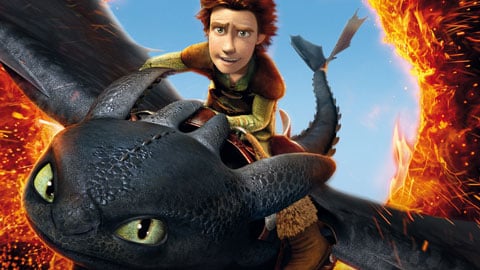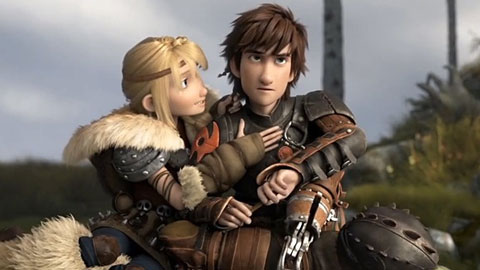





In the epical and super-spectacular second chapter of the trilogy, five years have passed since the heroic young Viking Hiccup (Jay Baruchel) befriended an injured dragon and forever changed the way the residents of Berk interact with the fire breathers. Now, Vikings and dragons live side-by-side in peace on the fantastical isle that has been transformed into a dragon's paradise. But when grown-up responsibilities loom on the horizon, Hiccup and his faithful dragon Toothless take to the skies in search of answers. It's much more than he bargained for, though, when Hiccup discovers that a mysterious dragon rider is really his long-lost mother Valka (Academy Award-winning actress Kate Blanchett) and that the peace between dragons and Vikings is threatened by the power-hungry Drago (Academy Award-nominated actor Djimon Hounsou) with help from the dragon trapper Eret, son of Eret (Game of Thrones actor Kit Harington).

As Astrid (America Ferrera), Gobber (Craig Ferguson) and Viking friends Snotlout (Jonah Hill), Fishlegs (Christopher Mintz-Plasse) and twins Ruffnut (Kristen Wiig) and Tuffnut (TJ Miller), lend their support, Hiccup, his mother and tribal chief father Stoick the Vast (Gerard Butler), must work together to protect the dragons they have grown to love. In the process, Hiccup finds the answers he has been looking for in ways he could never have imagined.
In 2010, DreamWorks Animation's How to Train Your Dragon soared into theatres and stole the hearts of audiences around the world with its blend of high-flying action, witty humour and dramatic depth, earning USD495 million in worldwide box office receipts and nabbing two Academy Award nominations along the way, for Best Animated Feature and Best Original Score.
But the success of the film, written and directed by Dean DeBlois and Chris Sanders, was gradual. Even though it was a critics' darling from the start and number one at the box office in its opening weekend "It actually underperformed according to studio expectations," DeBlois says. "But it had amazing legs. It clung at or near the top of the box office for seven weeks. We were all really proud of the fact that the word of mouth surrounding the movie was bringing audiences to see it, and bit by bit, we ended up surpassing studio expectations."
The triumph of How to Train Your Dragon spawned a TV series, a live stage show, a bevy of dragon merchandise and legions of loyal fans. "It's deeply satisfying to know that the passion we put into the film is reciprocated," DeBlois adds. "We see so much love coming back to us - fan videos and fan fiction and character drawings - it exists in a bigger way than we ever intended it to be."
After the first dragon wrapped and before production began on the second film, director Dean DeBlois, producer Bonnie Arnold, head of layout Gil Zimmerman, production designer Pierre Olivier Vincent (POV), supervising animator Simon Otto and supervising editor John Carr took a trip to Norway to glean inspiration from the Nordic setting.

"We had talked about doing it for movie one, since the film was obviously loosely based on Viking culture, but it didn't happen," Arnold says. "Then we felt it would be a good time, before we started movie two, before Dean even wrote the script, to take a trip to the Norwegian Folk Museum and the Viking Ship Museum in Oslo."
"The inspiration for me was most evident when we went to a fjord - just the sheer grandeur and spectacle of this big river with giant mountains coming out of the water as its banks," says Zimmerman, who, as head of layout, is to an animated film what a cinematographer is to a live-action one, responsible for the rough blocking of characters and cameras, working closely with the director and editor.
Offers Arnold: "It ended up being a little bit of a photo safari. We did a lot of research on Movie One, but things that we found there helped us to make Movie Two an even a better experience."
"My big take-away from that trip is the way it solidified us as a team," Zimmerman adds. "We developed investment in each other's lives and learned how to communicate really well with each other. The challenges of this movie really required that we had something other than just a corporate relationships to draw from."
Making any film, animated or live action, necessitates a lot of teamwork, but one might argue that How to Train Your Dragon 2, with its epic scale and scope, requires even more teamwork, especially as it's much more like an original story, with many new sets. In fact, only one from the first dragon- the isle of Berk - has been reused for dragon two.
"That's one of our most complex sets, so it did help us, especially early on," Zimmerman says. "One of the first scenes that we had to do was on Berk, but because of Hiccup's explorations, there are a lot of different worlds now. The first thing I got involved with is scouting sets with our production designer, PO V.
"Having Dean in the room with us deciding how we were going to stage things, what we needed to see, really gave us a sense of investment in the choices that we were making really early, as well as from a practical sense," he continues. "He was with us in the mo-cap room, too, when we moved the virtual camera around on the set and chose where we were going stage various parts of the action."
One of the early stages in the production process is called pre-visualisation, when the filmmakers fine-tune what scenes are going to look like. To achieve that on How to Train Your Dragon 2, the layout team relied heavily on motion capture technology as a tool (about 80% of the film's sequences went through the mo-cap room), which gave the filmmakers creative control of the camera and allowed them to stage scenes in different ways to find the most emotional impact.
"Gil has two guys on his crew that are also mixed martial arts fighters," says supervising editor John Carr. "When they were mapping out the scene where Stoick battles Drago, he put them in the mo-cap suits and let them go at it. They came up with a whole bunch of different scenarios." The scenes were then handed off to the artists and animators to further develop.

Returning as Hiccup is actor Jay Baruchel, who personifies those very qualities, according to DeBlois. "I can't think of anyone else who could ever play Hiccup in this way, because the character is Jay, to a large degree," he says. "He embodies so much of what Hiccup is: A guy who's quick-witted, intelligent, spry on his feet; there's an adorable awkward quality to him that he's very aware of and plays to his advantage."
And it's through Baruchel's ability to convey Hiccup's emotions that the audience connects with the character, says Arnold. "The audience is experiencing the movie through Hiccup. What makes the whole experience of the movie even more rewarding is understanding how Hiccup feels about a given situation," she says. "Jay is so passionate about the character and brings so much of that into his voice performance. As much as Dean is a great writer of the Hiccup dialogue - and he really is - Jay knows Hiccup better than anybody."
Even though their relationships have changed, one thing hasn't: Vikings are still Vikings and dragons are still dragons. The How to Train Your Dragon 2 team recognised that the citizens of Berk needed a new outlet for their natural aggressions, so they created dragon racing!
With Vikings on the backs of dragons "Dragon racing is exhilarating as long as you're not a sheep, I suspect," says Jay Baruchel. That's because participants have to head around the island hunting for the marked animals, scoop them up and dump them in a basket. Each one is worth a point; the black sheep is worth 10. "It's kind of like the Monte Carlo race of Berk," says DeBlois.
What is it about the dragon story that has touched the hearts of so many people? Producer Bonnie Arnold suggests that it's the universal appeal of Hiccup and Toothless' relationship. "This is the first time I've been a part of a film that continues to grow and become more beloved as time goes by," she says. "We still get little love letters from adults that say, 'Should I be embarrassed that I love H How to Train Your Dragon and I'm 40 years old?' It's exciting to know that people of all ages have been touched by the story and adventures of Hiccup and Toothless."
It's both awesome and frightening to be part of such a successful franchise, according to Gil Zimmerman: "It's awesome because we're incredibly proud of the first movie and humbled by the reaction that we have got from the many fans that we have out there people of every age and culture in the world. It's frightening because there is such a high expectation, you know? We want the fans to be every bit, if not more, excited about this story as they were about first one and hopefully, audiences will walk out of the theatres anticipating the third instalment of the franchise."
"My hope is the same for every film I work on," says David Walvoord, "that the audience feels like they've just seen something they've never seen before; that they think this was worth going to a theatre and experiencing with an audience. I hope that, for 90 minutes, they forget everything else and really believe that somewhere this universe exists a place where kids ride dragons, and then, hopefully, they'll go see the film again!"
"I've worked on a lot of projects, but it's rare that you work on one that touches this kind of a nerve," says head of story Tom Owens. "It's really special."
Sums up Jay Baruchel: "Being a part of the dragon franchise is one of the best things that ever happened to me. I had no idea when I showed up for the very first recording session, the adventure that it would take me on. I played one role out of thousands of people involved, but I'll just say I'm privileged to be involved in a movie that means as much as How to Train Your Dragon does to people."
If you are in for a weekend of Dragon Racing and awesome adventure in 3D,How To Train Your Dragon will sweep you off your feet.
For more on the film and other new releases, go to www.writingstudio.co.za.
